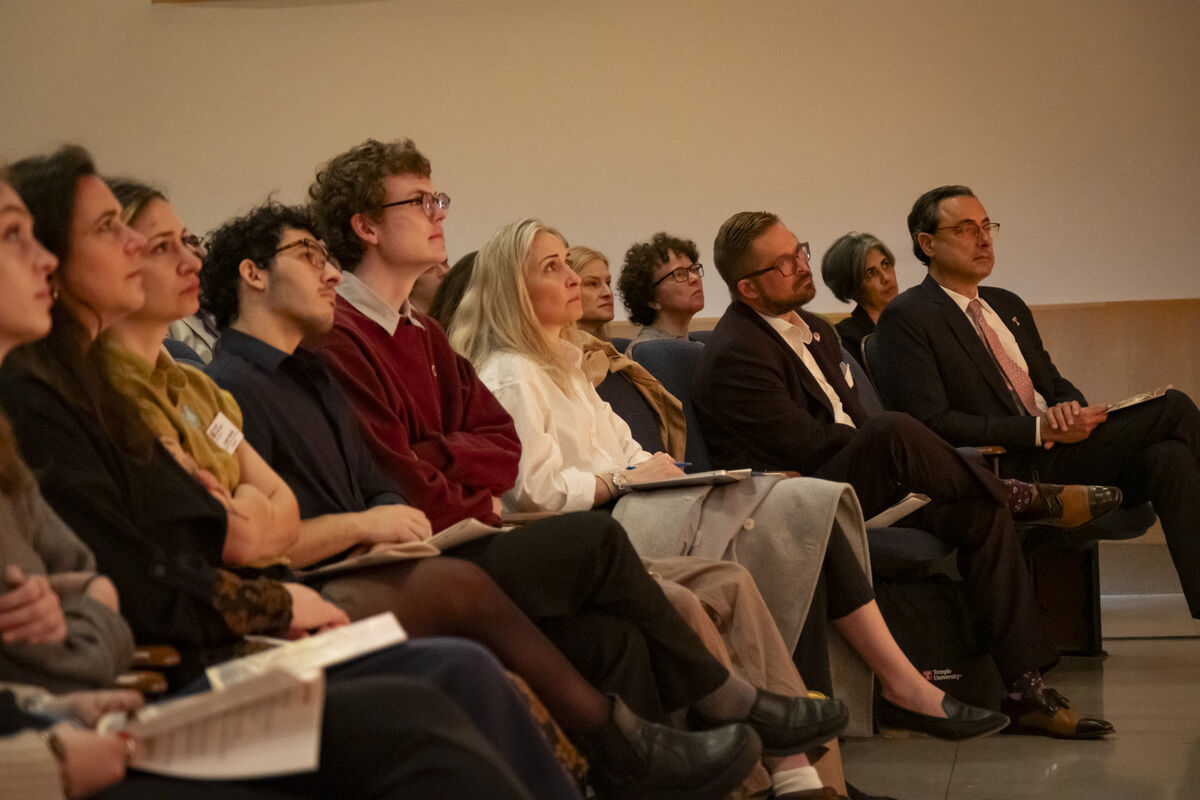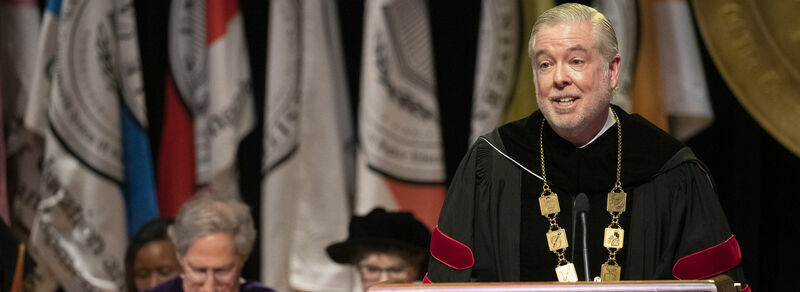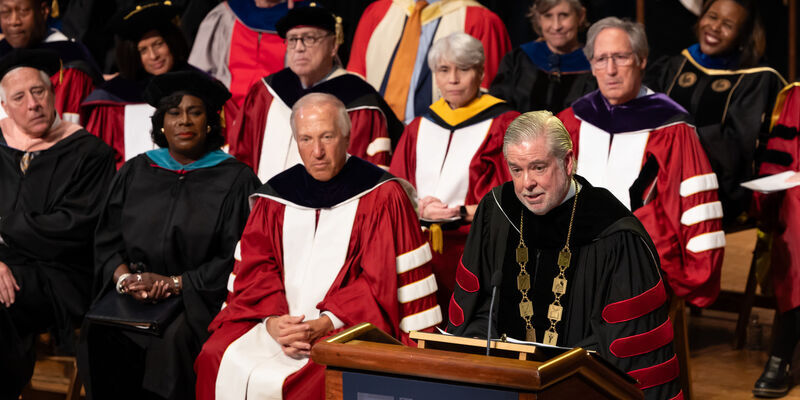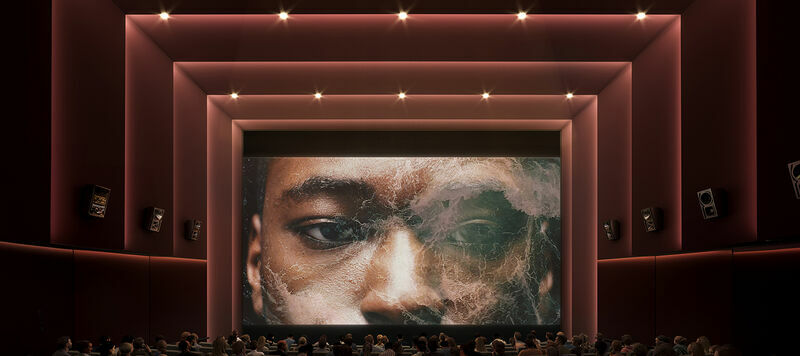Temple faculty, students shine at Innovation with Impact
Leading up to the investiture of President John A. Fry, a series of panel discussions, presentations and exhibits showcased the Temple community’s scholarly and creative work across its many schools and colleges.

During his April 4 investiture ceremony, President John A. Fry said Temple must go “all in” on “discovery, creativity and innovation.”
A series of panel discussions and presentations showcasing the important work of faculty and students from a range of disciplines leading up to the ceremony made clear that work is already well underway.
The events, brought together under Innovation with Impact, exemplified how the university continues to make groundbreaking contributions through scholarship, research, creative works and service.
These thought-provoking sessions underscored Temple’s commitment to advancing knowledge and impacting the everyday lives of real people—right here in Philadelphia and across the globe—in meaningful ways.
Innovations in research and teaching
In The Future of AI in Education and Research, panelists responded to the prompt of moderator and Vice Provost for Strategic Initiatives Richard Souvenir: How is artificial intelligence (AI) transforming the way we teach, learn, and conduct research?
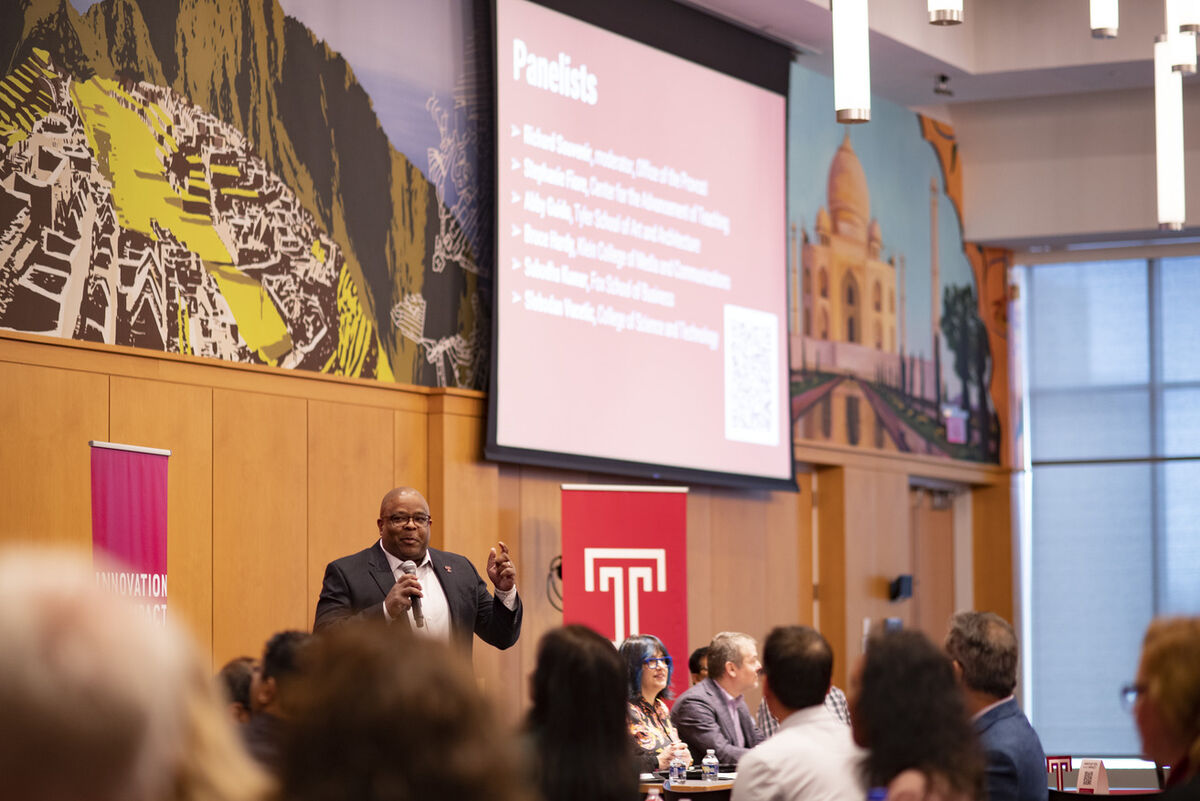
“AI can jumpstart creativity, but there will always be a need for a human touch,” said Abby Guido, associate professor of graphic and interactive design at Tyler School of Art and Architecture.
Stephanie Fiore, associate vice provost and senior director of the Center for the Advancement of Teaching, stressed the importance of AI literacy and ensuring that future generations are equipped to navigate an AI-driven world. “We need to prepare students for a world where AI will be ubiquitous, and we need to ensure equitable access to resources,” Fiore stated.
In response to the question, “How is AI different from past technological innovations?” Subodha Kumar, the Paul R. Anderson Distinguished Chair Professor at the Fox School of Business and director of the Center for Business Analytics and Disruptive Technologies, explained, “The impact of AI is bigger because it’s impacting almost all industries. The question is: How do we get the best out of it?”
Another panel, Working Together: Interdisciplinary Efforts to Promote Community Health, drew representatives from across Temple’s health professions to discuss their collaborative efforts to address pressing health challenges in North Philadelphia. Jennifer Ibrahim, dean of the College of Public Health, moderated the discussion and noted that Temple is shifting from a model of bringing services to the community to working alongside the community to address its needs. “We are not just providing services to the community; we are training the next generation of the workforce,” she explained.
As an example, Kenny Oh, assistant professor of surgery at the Lewis Katz School of Medicine, described his work providing healthcare screenings and educational sessions for community members in North Philadelphia. “We collaborated with owners of Black barbershops, and they invited us in; that trust is earned and built,” he said.
Moderated by David Boardman, dean of the Klein College of Media and Communication, Women in Sports Media: Progress and Challenges examined the trajectory of women in a field that remains largely male-dominated. One of the highlights was hearing Claire Smith, the first full-time female Major League Baseball beat writer, describe adversity she faced early in her career.
Smith, founding executive director of Klein College’s Claire Smith Center for Sports Media, shared her experience of being forcibly removed from a locker room during the 1984 National League Championship Series.
Despite ongoing obstacles, panelists celebrated the strides women have made in the field and concluded by expressing their commitment to mentoring the next generation.
Innovation was further explored during The Road to Invention: How Ideas Become Companies, moderated by Josh Gladden, vice president for research at Temple. Panelists included Christian Schafmeister, professor of chemistry in the College of Science and Technology and founder of ThirdLaw Molecular; Geoffrey Wright, professor and director of the neuromotor sciences program in the College of Public Health and co-founder of UprightVR; and Marvin Woodall, co-founder with Ryaz Bashir, professor of medicine at Lewis Katz School of Medicine, of Thrombolex.
Schafmeister’s work in molecular chemistry is advancing the development of enzymes that could potentially prevent future pandemics. Wright’s work in virtual reality technology aims to address balance deficits in patients, while Bashir and Woodall’s company is revolutionizing the treatment of pulmonary embolism.
Gladden stressed the critical role that commercialization plays in advancing society and shaping a better future. Wright agreed: “If I publish a paper, it may reach 100 people, but through commercialization, you have a chance to really make a difference.”
Arts and Innovation Showcase
In Rock Hall, Cybersounds, presented by the Boyer College Electroacoustic Ensemble Project (BEEP), offered electroacoustic music, blending styles from electronic dance music to abstract classical compositions.
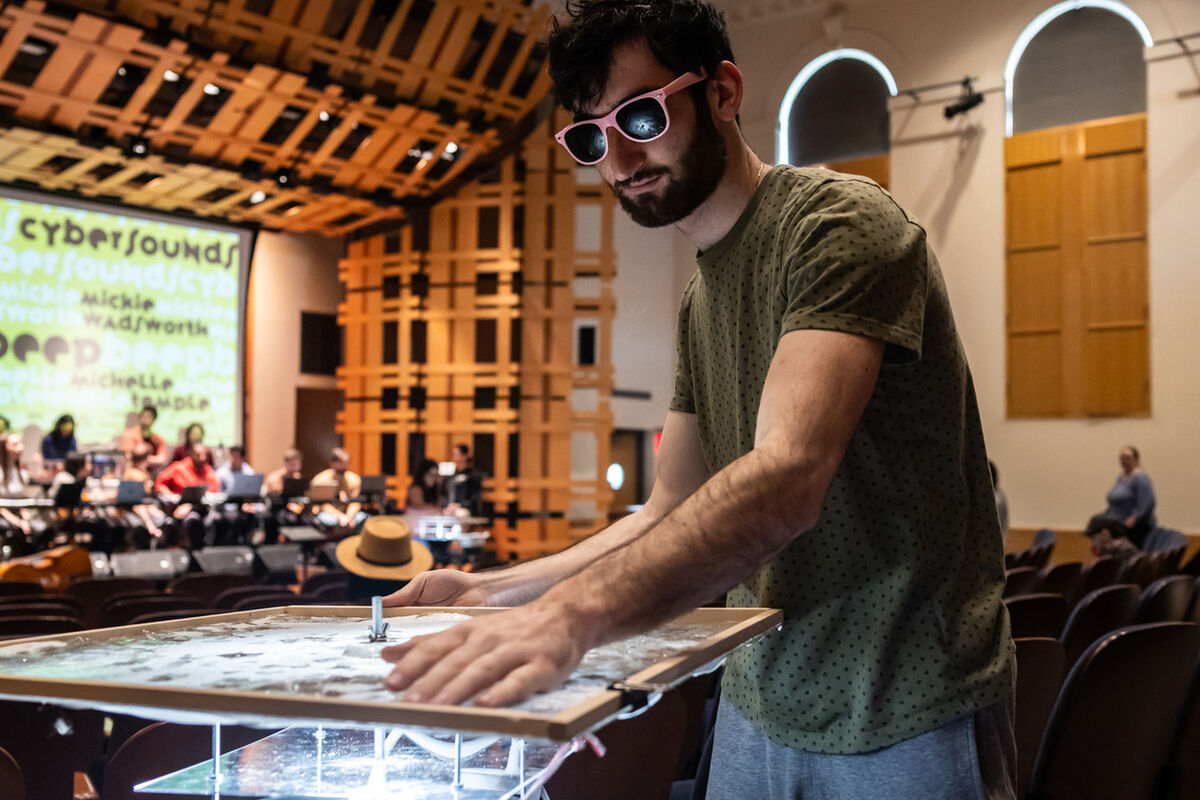
Upon entering the auditorium, attendees encountered a multimedia piece by Associate Professor of Music Studies Michelle Temple. A large subwoofer played a single tone at varying volumes beneath a moving plastic sheet, illuminated by a bulb. Visitors donned polarized sunglasses, sprinkled mica and salt over the sheet, and watched it dance in the light as it was moved by the soundwaves.
Audience members of Community Poetics and Ethno-Photography viewed photos of Philadelphia from 1980 through 2000 while listening to poetic narratives inspired by the images, written and performed by Kimmika Williams-Witherspoon, senior associate dean of strategic initiatives and innovation in the Center for the Performing and Cinematic Arts and a professor in the Theater Department. Senior University Photographer Joseph V. Labolito explained how he created the photographs and how the photographs, in turn, shaped his view of the city.
At Artscape, jewelry, metals, glass, visual studies and painting students displayed their BFA and MFA projects in Tyler’s exhibition spaces and hallways. In one interactive installation—part of the thesis exhibit of MFA candidate Molly Hanson—visitors could walk over an ornate rug with broken glass underneath, feeling it crack beneath their feet.
Outside in Tyler’s courtyard, attendees enjoyed the “Tree of 40 Fruit”—a multi-grafted tree producing forty different heirloom and antique fruit varieties recently planted by the 2025 Jack Wolgin Visiting Artist Sam Van Aken.
Temple Talks
During Temple Talks, faculty members from diverse fields shared their groundbreaking ideas and innovative research in six-minute presentations.
President John Fry opened the event with remarks emphasizing the role of faculty in catalyzing scientific, technological and cultural innovation.
“It’s important to me that we shine the spotlight on our faculty, on their ideas, their discoveries and their commitment to knowledge that drives change because faculty are the heart of Temple," he said. "They make us who we are.”

Rethinking Global Migration Law
Addressing the critical issue of global migration law, Jaya Ramji-Nogales, associate dean for research at Temple’s Beasley School of Law, explained that international law governing human mobility is often fragmented, and how current policies fail to adequately protect migrants. She proposed a comprehensive solution that incorporates technology to better anticipate migration patterns and build infrastructure that supports lawful movement and integration. According to Ramji-Nogales, any solution must prioritize safe transit and create systems to accommodate the flow of people with dignity and respect.
How to Think Like a Brain
Using cat pictures to illustrate his point, Iyad Obeid, a professor in the College of Engineering, described how the human brain can easily recognize patterns, a task that computers traditionally struggled to perform. With the rise of machine learning, computers can now complete similar tasks with increasing proficiency, yet Obeid pointed out that there are limits to AI’s capabilities. For example, a self-driving car may fail to distinguish between a road and a picture of a road. He highlighted how engineers and neuroscientists are working together to improve AI by mimicking the brain’s neural networks, but acknowledged that true brain-like intelligence in machines remains an ongoing challenge.
Why Agency Matters in Education
Maia Cucchiara, associate professor of urban education in the College of Education and Human Development, discussed the importance of promoting agency in education. Through her research at two high schools in Philadelphia serving low-income students, Cucchiara found that empowering students to set goals, reflect on their progress and take ownership of their success were keys to their academic progress. Cucchiara emphasized the need to prioritize agency-building in schools, particularly those serving marginalized communities. She advocates for a rethinking of what constitutes school success, arguing that students’ ability to exercise agency should be a core metric.
Innovations in Deep-sea Research to Address Human Impacts
“Exploring the deep sea is like exploring an alien landscape once you get down there,” explained Erik Cordes, a professor in the College of Science and Technology. Recently, Cordes and his team made remarkable discoveries in the South Sandwich Islands, an active volcanic archipelago, where they mapped cold-water coral gardens for the first time. Their research is advancing methods for creating artificial corals to help restore marine ecosystems. Cordes called for the establishment of protected areas that would cover 30% of the world’s oceans by 2030, ensuring that these fragile environments remain untouched and resilient in the face of climate change.
Why Media for Children Matters the Most
“Can you tell me how to get ...” sang Sherri Hope Culver, of the Klein College of Media and Communication, who began her talk reminding the audience of the children’s TV shows that had played a role in their own development. She stressed that children remain profoundly impacted by the media they consume and the content they engage with can shape their future behaviors, attitudes and worldviews. Culver’s talk underscored the importance of creating thoughtful and meaningful media content that contributes positively to children’s growth and well-being.
Clean Slate: Opportunities and Burdens in Criminal Record Relief
One in three adults in the U.S. has a criminal record, Associate Professor of Political Science Nyron Crawford told the audience, and many face significant barriers to employment and reintegration into society as a result. People with criminal records report difficulty finding a job, securing quality housing, receiving public assistance, obtaining an education and paying their bills, and this is especially true for individuals convicted of felonies. Crawford’s research focuses on providing relief options for those burdened by criminal records, offering a path to greater societal and economic participation.
“My personal experiences and those of friends and loved ones have helped me understand the effects and consequences of a criminal record,” he said. “Being a professor and researcher at Temple has given me the opportunity to solve it.”
Acres of Diamonds: Community-based Inspiration for Innovation
Zoe Maher, associate professor of surgery at the Lewis Katz School of Medicine and a trauma surgeon at Temple University Hospital, discussed her work in promoting global health equity and justice. She recounted Kareem, a man she operated on after he was shot: “Our community deserves so much more than survival,” she explained.
Kareem called two years later to tell her about his small business and the book he’d written about survivors of gun violence as well as to thank her for the excellent care. Today, her goal is to eradicate firearm injury.
“What we do here matters,” she said. “I’m so proud to be able to innovate and work toward global health equity and justice.”
Solving the Crisis of Systemic Attention
Ravi Kudesia, assistant professor of management in the Fox School of Business, argued that attention—often treated as a currency—is central to both individual and collective performance within organizations. He and his colleagues analyzed 80 case studies of impactful social crises; the common denominator was the collapse of systemic attention. He works to help organizations implement social practices that get people from different parts of an organization talking with one another.
By fostering a culture of attention, Kudesia believes organizations can improve both productivity and relationships.
Reimagining the Power Structure in Collaborative Art Spaces
Amina Robinson, professor of acting and musical theater in the School of Theater, Film and Media Arts, advocates for valuing every participant’s contribution to the creative process, believing it fosters trust and investment from all involved. By restructuring traditional power hierarchies, Robinson argued, art spaces can become more inclusive and empowering for all contributors.
“It does not diminish my power to value everyone’s contribution; in fact, it increases the amount of trust people put in me to lead them to the finish line,” she said. “It increases the level of investment from everyone involved as they are bona fide stakeholders in the artmaking.”
